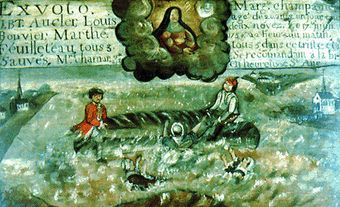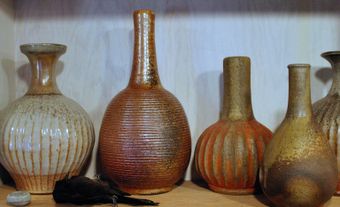Maud Kathleen Lewis (née Dowley), artist (born 7 March 1901 or 1903 in Yarmouth, NS; died 30 July 1970 in Digby, NS). Maud Lewis was a Canadian painter and folk artist. Her artistic talents were largely hidden throughout much of her life — a result of poverty, shyness and social anxiety brought on by suffering from severe birth defects. Often referred to as Canada’s Grandma Moses, Lewis came to national prominence in the mid-1960s, just a few years before her death. Her work, which has been sold at auctions and been featured on postage stamps, has become widely popular. The small house where she lived and worked is on permanent display at the Art Gallery of Nova Scotia.

Early Life
Maud Lewis was born to John and Agnes Dowley around the turn of the 20th century in rural Nova Scotia. She had an older brother, Charles, born in 1897. She lived nearly her entire life in Digby and Yarmouth counties. She was born at the Yarmouth hospital, spent her early life in nearby South Ohio and her adult life in the village of Marshalltown, outside Digby. In a 1965 interview with the CBC, Lewis indicated that the farthest she had ever travelled was to Halifax.
Lewis was born with several severe birth defects. She was frail and small-statured, with sloping shoulders, a curved spine and a heavily recessed chin. Her hands and fingers were also deformed. Her physical ailments were not well-understood or diagnosed during her life, though it is now suspected she suffered from juvenile rheumatoid arthritis. This condition worsened over the course of her life and was likely quite painful.
Lewis grew up in relative comfort. Her father was a blacksmith and harness-maker — skilled trades that allowed the Dowley family to largely avoid the cyclical poverty that was endemic to the region. She went to school in a one-room schoolhouse in South Ohio. She learned to paint, sew and crochet, as well as other artistic and decorative pastimes considered appropriate for girls of her era. Her mother also taught her how to play the piano before her fingers were crippled by arthritis.
The family moved to Yarmouth, Nova Scotia, in 1914. Her father ran a profitable harness shop there for the next three decades. Her brother, Charles, had already moved there and worked as the manager of a local theatre. Maud completed Grade 5 by age 14, though it is unclear why. She also experienced bullying in her youth due to her disabilities. Though these limitations prevented her from getting a job, it did not stop her from contributing to her household. With the encouragement of her mother, she painted and sold Christmas cards and decorations door-to-door.
Lewis lived with her parents in Yarmouth well into adulthood, and typically stayed at home. However, in 1928 she gave birth to a daughter, Catherine Dowley, who was likely fathered by a man named Emery Allen. Allen abandoned Lewis shortly after Catherine’s birth. Lewis never acknowledged Catherine as her child, despite the latter’s efforts to connect with her. It was never explained why.
Adult Life and Marriage to Everett Lewis
Maud’s father passed away in 1935. Her mother died in 1937. Without her parents to care for her, she lived briefly with her brother Charles and his wife. As was the convention at the time, the modest estate went to her brother, leaving Maud with nothing. After her brother’s marriage fell apart, Maud went to live with an aunt in Digby. She remained in Digby County for the rest of her life.

In 1938, Maud responded to an advertisement from a man named Everett Lewis seeking a housekeeper. They fell in love and married in 1938. Everett Lewis was an itinerant fish monger who kept a modest cottage in the small community of Marshalltown. Everett had been raised in the Nova Scotia Alms House on account of his birth father abandoning him and his mother. He received little education and could neither read nor write. The couple lived together in Lewis’s modest house. It was little more than a shack, with no plumbing, running water or electricity.
Though Maud had initially met Everett because the latter was seeking a housekeeper, her arthritis continued to worsen as she aged. Everett was required to take care of all housework. Maud supported the household by selling her paintings directly from their house, which was located close to the main road connecting Digby with Yarmouth. Its proximity to the ferry terminals also meant there was a steady stream of tourists for much of the year. Eventually, Everett devoted all his time to helping to sell Maud’s painting. Initially, she sold paintings to locals and neighbours. But as her reputation developed, she increasingly sold paintings to tourists and people who made their way deliberately to find her. She also painted the interior and exterior of the home, as well as some of its furniture, and hand-painted the sign that advertised “PAINTINGS, FOR SALE. M. LEWIS.”
Exposure and Fame
Maud Lewis only gained international renown in the last five years of her life. In 1965, she was the subject of a CBC TV interview and an article in the Toronto Star. Interest in her work grew to such an extent that her patrons included US President Richard Nixon, whose office commissioned two paintings from her.
Maud Lewis died of pneumonia in 1970. She was buried in a child’s coffin in a pauper’s grave at the North Range Cemetery south of Marshalltown. Everett Lewis died tragically in 1979, when he was murdered during a robbery of his house.
Following Everett’s death, local residents formed the Maud Lewis Painted House Society to preserve the house as a cultural landmark. In 1984, the house was sold to the Art Gallery of Nova Scotia (AGNS) in Halifax. It had the house carefully disassembled and then reassembled in the gallery, where it has been on permanent display since 1998.

Artistic Style
Maud Lewis’s artwork focuses on scenes from daily life in rural Digby County, and on the landscape of southwestern Nova Scotia. Her works are cheerful scenes characterized by bright colours. Her distinctive style is a consequence of her lack of formal artistic training. They are reminiscent, in style, form, colour, and composition, of children’s drawings, though they are more consistent and more realistic, albeit impressionistic.
She frequently painted on a wide variety of materials, including cardboard, particleboard, clam shells, and even dustpans. The scenes she painted often depicted farm life: ox or horse teams pulling ploughs, sleigh rides through fields, chickens and their chicks. She also painted a wide variety of landscapes in all seasons, and frequently painted animals into these compositions. She painted no indoor scenes, nor did she paint scenes of city life. Her work has been described as without shadows or shade, though her works do in fact incorporate both.
Occasionally, her paintings have surreal qualities to them, such as pine trees blooming with flowers, or winter scenes with trees exhibiting the multicoloured leaves of autumn. The bright, lighthearted and joyful scenes of her artwork contrast sharply with the physical pain she experienced throughout her life. Her works have often been compared to those of the American painter Anna Marie Robertson (a.k.a. Grandma Moses).

Honours
After Maud and Everett’s house was moved to the AGNS, a memorial replica of the house was built on the same site in Marshalltown by architect Brian MacKay-Lyons. He reportedly chose grey steel for the material “to convey the somber reality of Maud’s life.” The structure is now part of Maud Lewis Memorial Park. Another replica of the Lewis house was built in nearby Seabrook by local resident Murray Ross in the late 1990s.
In 2019, the province of Nova Scotia honoured Lewis as the subject of Heritage Day. The provincial holiday recognizes “a person, place or event that helped shape the province's history and identity.” The honour also included a commemorative stamp issued by Canada Post. It also issued another three stamps — featuring Lewis’s Family and Sled, Team of Oxen in Winter and Winter Sleigh Ride — in 2020.
Auctioned Works
As interest in Lewis’s work has increased over the years, so too has the value of her paintings. In 2009, her painting The Family Outing sold for $22,000 at an auction in Toronto. Her Portrait of Eddie Barnes and Ed Murphy, Lobster Fishermen, Bay View, N.S., which was found at an Ontario thrift store in 2017, sold for $45,000 at an online auction later that year. Lewis’s painting Black Truck, which was traded by artist John Kinnear to an Ontario restauranteur in 1973 in exchange for an artisanal grilled cheese sandwich, netted a whopping $350,000 (US$272,000) in 2022. Three hand-written letters by Lewis to Kinnear, in which she thanked him for helping to support her work, sold for $70,000.
In Popular Culture
The significant spike of interest in Lewis’s work — and its value — in recent years has been due in no small part to the movie Maudie (2016). Starring Sally Hawkins as Maud Lewis and Ethan Hawke as Everett, the film had its Canadian premiere at the Toronto International Film Festival and went on to become a modest hit in North America and internationally. It also won seven Canadian Screen Awards.
Maud Lewis has been the subject of two National Film Board documentaries: Maud Lewis: A World Without Shadows (1976) and I Can Make Art … Like Maud Lewis (2005). Lance Woolaver’s biography of Lewis, The Illuminated Life of Maud Lewis, was published in 1996. It was also the basis for a documentary of the same name that was released in 1998. Also in 1998, composer Nikolai Korndorf wrote the orchestral piece The Smile of Maud Lewis. In 2009, the AGNS produced Greg Thompson’s play A Happy Heart: The Maud Lewis Story.
See also Paying Tribute to Painter Maud Lewis.

 Share on Facebook
Share on Facebook Share on X
Share on X Share by Email
Share by Email Share on Google Classroom
Share on Google Classroom


